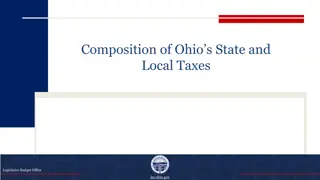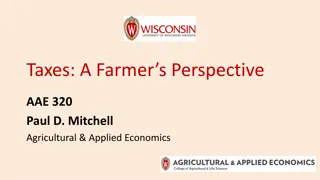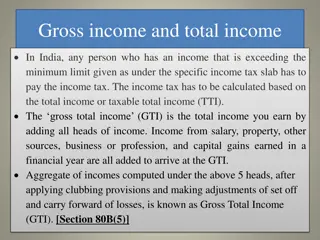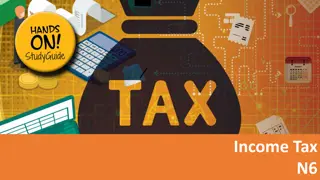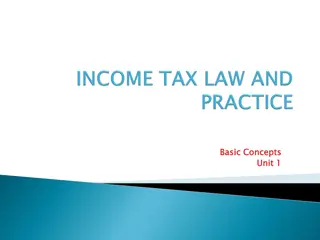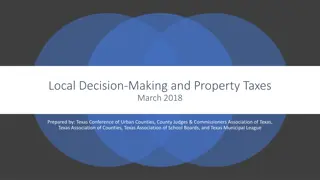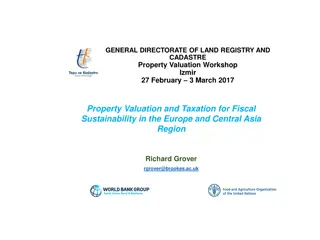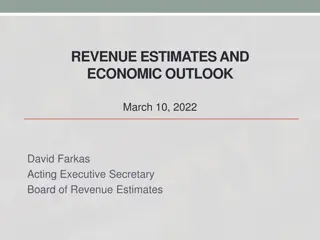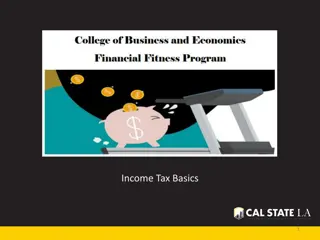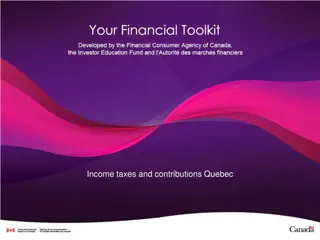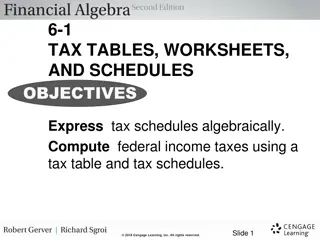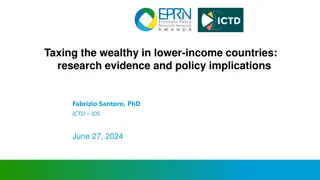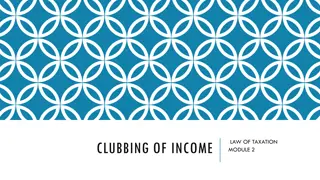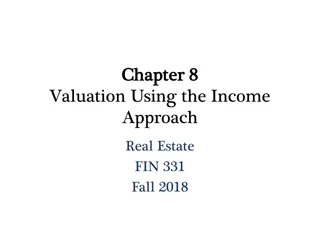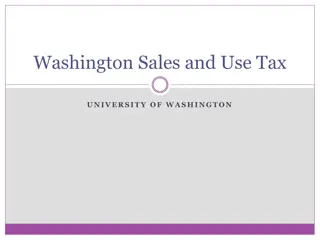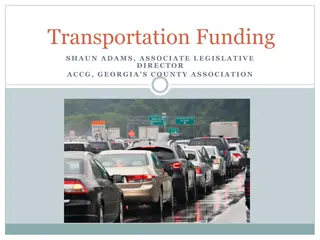Understanding State and Local Sales and Income Taxes
Delve into the intricacies of state and local sales and income taxes in Lecture 10 of State and Local Public Finance. Explore topics such as efficiency, equity, administrative issues, design of federal tax, link to state income taxes, and design of local income taxes. Uncover how sales taxes create distortions and examine the impact on government revenue and excess burden. Discover how tax policies affect goods with inelastic demand and the interplay between taxation, distortions, and equity considerations.
Download Presentation

Please find below an Image/Link to download the presentation.
The content on the website is provided AS IS for your information and personal use only. It may not be sold, licensed, or shared on other websites without obtaining consent from the author. Download presentation by click this link. If you encounter any issues during the download, it is possible that the publisher has removed the file from their server.
E N D
Presentation Transcript
State and Local Public Finance State and Local Public Finance Professor Yinger Professor Yinger Spring 2022 Spring 2022 LECTURE 10 STATE AND LOCAL SALES AND INCOME TAXES
State and Local Public Finance State and Local Public Finance Lecture 10: State and Local Sales and Income Taxes Lecture 10: State and Local Sales and Income Taxes Class Outline Sales Taxes Efficiency Equity Administrative Issues Income Taxes Design of Federal Tax Link to State Income Taxes Design of Local Income Taxes
State and Local Public Finance State and Local Public Finance Lecture 10: State and Local Sales and Income Taxes Lecture 10: State and Local Sales and Income Taxes Class Outline Sales Taxes Efficiency Equity Administrative Issues Income Taxes Design of Federal Tax Link to State Income Taxes Design of Local Income Taxes
State and Local Public Finance State and Local Public Finance Lecture 10: State and Local Sales and Income Taxes Lecture 10: State and Local Sales and Income Taxes Sales Tax Distortion All taxes cause distortion (i.e., inefficiency), measured by excess burden. The sales tax is no exception. A sales tax distorts choices between taxed and untaxed items. Food and medicine are generally not taxed. Services are often not taxes. All else equal, the best tax has the lowest excess burden.
State and Local Public Finance State and Local Public Finance Lecture 10: State and Local Sales and Income Taxes Lecture 10: State and Local Sales and Income Taxes Sales Tax Distortion, 2 Government Revenue P Excess Burden P2 S + Tax P = t P1 S Q D Q2 Q1 Q Q The Market for Taxed Goods
State and Local Public Finance State and Local Public Finance Lecture 10: State and Local Sales and Income Taxes Lecture 10: State and Local Sales and Income Taxes Excess Burden And Policy Distortions are smallest for taxed goods with inelastic demand, such as medicine or cigarettes. Distortions arise when goods are taxed and services are not or when some goods (e.g., food or medicine) are exempt from tax. Distortions may arise when intermediate goods or services (i.e., inputs) are taxed. Taxes can reduce distortions when there are externalities. Equity concerns may overrule distortion concerns!
State and Local Public Finance State and Local Public Finance Lecture 10: State and Local Sales and Income Taxes Lecture 10: State and Local Sales and Income Taxes Sales Tax Distortion, 3 Tax to Offset Externality Government Revenue P PMC = Private marginal cost Excess Burden Avoided with Tax = SMC P2 SMC = Social marginal cost S + Tax = PMC + SMC P = t P1 S = PMC Q D Q2 Q1 Q Q The Market for Taxed Goods
State and Local Public Finance State and Local Public Finance Lecture 10: State and Local Sales and Income Taxes Lecture 10: State and Local Sales and Income Taxes Excess Burden And Policy, 2 Driving (=gasoline use) causes air pollution and emits greenhouse gases; a gas tax therefore promotes efficiency by discouraging driving! The federal gas tax has declined 40% in real terms since 1993. One study finds that fuel-efficiency standards for new cars would cost the U.S. 6 times as much for the same reduction in gas use as setting the gas tax at $0.45 per gallon. See Karplus, New York Times, February 21, 2013. https://www.nytimes.com/2013/02/22/opinion/the-case- for-a-higher-gasoline-tax.html
State and Local Public Finance State and Local Public Finance Lecture 10: State and Local Sales and Income Taxes Lecture 10: State and Local Sales and Income Taxes Sales Tax Incidence As noted above, sales taxes do not generally apply to all markets. Food, medicine, services, and housing are not usually taxed. This means that suppliers have alternatives, and the supply curve is quite elastic. On the household side, sales taxes can be seen as a tax on consumption, so they distort the choice between work and leisure. The labor supply elasticity is small, however, so households cannot escape the tax. The punchline is that the incidence of a general sales tax is thought to fall mainly on consumers.
State and Local Public Finance State and Local Public Finance Lecture 10: State and Local Sales and Income Taxes Lecture 10: State and Local Sales and Income Taxes Sales Tax Incidence, 3 P P2 S+tax P1=P3 S D Q The supply of taxed goods is elastic, and the demand curve is inelastic, so most of the burden of sales tax differences falls on consumers.
State and Local Public Finance State and Local Public Finance Lecture 10: State and Local Sales and Income Taxes Lecture 10: State and Local Sales and Income Taxes Sales Tax Incidence, 4 The ratio of consumption to income declines as income rises. In other words, rich people save a larger share of their income. So a sales tax is regressive overall. o Some components of a sales tax (e.g., a sales tax on luxury goods or services) might be progressive.
State and Local Public Finance State and Local Public Finance Lecture 10: State and Local Sales and Income Taxes Lecture 10: State and Local Sales and Income Taxes Sales Tax Incidence, Cont. T Y Progressive Proportional Regressive Y
State and Local Public Finance State and Local Public Finance Lecture 10: State and Local Sales and Income Taxes Lecture 10: State and Local Sales and Income Taxes A Key Administrative Issue In The Design of a Sales Tax According to the 1992 Quill decision by the U.S. Supreme Court, sales taxes on mail order or internet sales could only be collected if the seller has a business nexus in a state. o This decision was based on the inter-state commerce clause of the U.S. Constitution, which prohibits one state from placing an undue burden on businesses in other states. o It cost the states billions of dollars and was a major source of distortion. This decision was overturned in June 2018 by the Wayfair decision. o This decision applied directly to South Dakota, but set up rules that other states could use to tax mail order or internet sales.
State and Local Public Finance State and Local Public Finance Lecture 10: State and Local Sales and Income Taxes Lecture 10: State and Local Sales and Income Taxes A Key Administrative Issue In The Design of a Sales Tax, 2 In response to the Quill decision, many states joined an interstate compact to create uniform definitions and rates for state sales taxes. These steps lowered the burden of collecting the sales tax, which was the basis of the Quill decision and hence led to Wayfair. In addition, New York won a case arguing that Amazon had to collect taxes for New York customers because they had affiliates (economic nexus) in New York, even though it did not have offices in New York (physical nexus). By the way, Amazon eventually realized that it might as well have physical nexus, at least in big states, because this step could increase delivery speeds, which customers value.
State and Local Public Finance State and Local Public Finance Lecture 10: State and Local Sales and Income Taxes Lecture 10: State and Local Sales and Income Taxes A Key Administrative Issue In The Design of a Sales Tax, 3 Prior to Wayfair, states could only enforce a tax collection obligation on businesses that had a physical presence in the state, such as a brick-and-mortar location or remote employees. While the physical presence standard still exists, nexus laws were expanded to include a sales tax obligation based on a certain level of economic activity within the state, including sales revenue, transaction volume, or a combination of both. Like many sales tax laws, economic nexus criteria vary by state and by the type of tax. As of November 2021, 46 states have nexus laws. https://www.avalara.com/us/en/learn/guides/state-by-state-guide- economic-nexus-laws.html
State and Local Public Finance State and Local Public Finance Lecture 10: State and Local Sales and Income Taxes Lecture 10: State and Local Sales and Income Taxes The Use Tax The sales tax is actually a sales and use tax. o A resident of State X owes the sales tax to State X even if he or she buys something subject to the sales tax in State Y and then brings it home. o The new Supreme Court decision helps with internet sales but does not eliminate all administrative problems. The use tax is still hard to administer in some cases: o Massachusetts police parked at New Hampshire liquor stores. o Interstate agreements to share credit card information for large purchases in one state delivered to another without collection of sales taxes (unless the state nexus law applies to these sales).
State and Local Public Finance State and Local Public Finance Lecture 10: State and Local Sales and Income Taxes Lecture 10: State and Local Sales and Income Taxes Questions What is the excess burden (= deadweight loss ) from a sales tax? How does the price elasticity of demand for a taxed good affect excess burden from a sales tax? Can the excess burden ever be negative? Why are sales taxes thought to be regressive? What is a use tax and why does it affect internet sales?
State and Local Public Finance State and Local Public Finance Lecture 10: State and Local Sales and Income Taxes Lecture 10: State and Local Sales and Income Taxes Class Outline Sales Taxes Efficiency Equity Administrative Issues Income Taxes Design of Federal Tax Link to State Income Taxes Design of Local Income Taxes
State and Local Public Finance State and Local Public Finance Lecture 10: State and Local Sales and Income Taxes Lecture 10: State and Local Sales and Income Taxes The Federal Income Tax We start with the federal income tax because most state taxes are linked to it. We will discuss the broad issues in the design of the federal income tax. Then we will turn to state and local income taxes.
State and Local Public Finance State and Local Public Finance Lecture 10: State and Local Sales and Income Taxes Lecture 10: State and Local Sales and Income Taxes Federal Income Tax Design Comprehensive Income - Exclusions = Adjusted Gross Income - Exemptions - Deductions (Itemized or Standard) = Taxable Income Tax Table = Gross Tax - Tax Credits = Net Tax
State and Local Public Finance State and Local Public Finance Lecture 10: State and Local Sales and Income Taxes Lecture 10: State and Local Sales and Income Taxes Exclusions & Exemptions Exclusions Interest income on municipal bonds Implicit rent on owner-occupied housing Exemptions (Eliminated by the 2017 Tax Cuts and Jobs Act, TCJA) Personal exemptions ($4,050) Exemptions for dependents Exemptions for age and some categories of disability
State and Local Public Finance State and Local Public Finance Lecture 10: State and Local Sales and Income Taxes Lecture 10: State and Local Sales and Income Taxes Deductions Itemized Deductions Mortgage interest on primary residence (and some secondary) Property taxes on primary residence (and some secondary) State income taxes (or state sales taxes but not both!) Charitable contributions Excess medical expenses Limited to $10,000 by TCJA Standard Deduction Fixed amount (used by most taxpayers) $12,700 for joint return (increased to $25,100 in 2021 by TCJA)
State and Local Public Finance State and Local Public Finance Lecture 10: State and Local Sales and Income Taxes Lecture 10: State and Local Sales and Income Taxes Tax Expenditures Another way to look at tax policy is through the lens of provisions that subsidize various activities, called tax expenditures. According to the Tax Policy Center, The cost of the deduction of state and local income, sales, and property taxes will decline from $100.9 billion in 2017 to only $21.2 billion in 2019 because of the increase in the standard deduction and because the tax deduction is now limited to no more than $10,000 per tax return. Other large tax expenditures relevant to state and local government include the tax exemption for state and local government bonds, which is discussed in a later class.
State and Local Public Finance State and Local Public Finance Lecture 10: State and Local Sales and Income Taxes Lecture 10: State and Local Sales and Income Taxes Tax Calculations Tax Tables Separate tables for married and single. o A marriage penalty for equal-earning couples due to standard deduction. o A marriage bonus for one-earner couples due to broader brackets. The alternative minimum tax (AMT) tries to ensure that exemptions and deductions do not push the average tax rate too low. o The AMT exemptions were increased a lot by TCJA. o The AMT serves to reclaim some revenue lost to other provisions. Tax Credits Earned income tax credit
State and Local Public Finance State and Local Public Finance Lecture 10: State and Local Sales and Income Taxes Lecture 10: State and Local Sales and Income Taxes Tax Table, Joint Returns, 2017 (2021) Marginal Rate 39.6% 37.0% 10% $18,650 $19,900 $470,700 $628,301 Taxable Income
State and Local Public Finance State and Local Public Finance Lecture 10: State and Local Sales and Income Taxes Lecture 10: State and Local Sales and Income Taxes Marginal To Average Rates The translation from marginal to average rates is complicated. o Marginal rate tables are misleading due to the EITC. o All the other features of the tax code affect average rates. o Deductions are particularly powerful at the highest income levels. Many states have their own EITC.
State and Local Public Finance State and Local Public Finance Lecture 10: State and Local Sales and Income Taxes Lecture 10: State and Local Sales and Income Taxes
State and Local Public Finance State and Local Public Finance Lecture 10: State and Local Sales and Income Taxes Lecture 10: State and Local Sales and Income Taxes Earned Income Tax Credit Parameters, 2020 [Dollar amounts unadjusted for inflation] Minimum income for Phaseout range [1] Credit Phaseout rate maximum Maximum rate Beginning Ending Calendar year (percent) credit credit (percent) income income 2020 No children 7.65 7,030 538 7.65 8,790 15,820 One child 34 10,540 3,584 15.98 19,330 41,576 Two children 40 14,800 5,920 21.06 19,330 47,440 Three children 45 14,800 6,660 21.06 19,330 50,954 Source: Tax Policy Center
State and Local Public Finance State and Local Public Finance Lecture 10: State and Local Sales and Income Taxes Lecture 10: State and Local Sales and Income Taxes
State and Local Public Finance State and Local Public Finance Lecture 10: State and Local Sales and Income Taxes Lecture 10: State and Local Sales and Income Taxes Possible Average Rate Figure Itemized Deductions, AMT T Y Zero Income Amount (Exemptions + Standard Deduction) ? After 2017 TCJA? 0 Comprehensive Income EITC
State and Local Public Finance State and Local Public Finance Lecture 10: State and Local Sales and Income Taxes Lecture 10: State and Local Sales and Income Taxes Average Federal Income Tax Rates, 2009-2013 30% 25% 20% 15% 10% 5% 0% $1,000 $10,000 $100,000 Adjusted Gross Income 2010 $1,000,000 $10,000,000 $100,000,000 2009 2011 2012 2013 Source: IRS. Note that negative rates form the EITC cannot be identified in the IRS data.
State and Local Public Finance State and Local Public Finance Lecture 10: State and Local Sales and Income Taxes Lecture 10: State and Local Sales and Income Taxes State Income Taxes State income taxes are less progressive than the federal income tax. o States worry about scaring away high-income residents, although I have not seen any evidence that this is a large effect. State top rates go as high as 12.3 % (California), and 9 states have a flat rate. Eight states do not have an income tax, and New Hampshire only taxes dividend and interest income. For more, see: https://www.taxpolicycenter.org/statistics/state- individual-income-tax-rates
State and Local Public Finance State and Local Public Finance Lecture 10: State and Local Sales and Income Taxes Lecture 10: State and Local Sales and Income Taxes Tax Reform Act Of 1986 (TRA) This was a remarkable bi-partisan reform that closed loopholes (favored by liberals) and lowered marginal rates (favored by conservatives). These two are linked broadening the base makes lower rates possible. Since then loopholes have been added at a furious pace. This reform also shifted the burden from individuals to corporations.
State and Local Public Finance State and Local Public Finance Lecture 10: State and Local Sales and Income Taxes Lecture 10: State and Local Sales and Income Taxes Link To State Income Taxes Most state income taxes either o A. use federal taxable income and their own tax tables, or o B. set their tax as a percentage of federal tax. The A states gained from base broadening in the 1986 TRA. The B states lost from the shift away from individual income taxes in the 1986 TRA.
State and Local Public Finance State and Local Public Finance Lecture 10: State and Local Sales and Income Taxes Lecture 10: State and Local Sales and Income Taxes The Tax Cuts and Jobs Act of 2017 (TCJA) The same issues arise with TCJA. Possible revenue raisers for states: Personal Exemption Elimination The federal tax bill will repeal personal exemptions. Ten states currently couple their state personal exemption with the federal personal exemption. Given that the federal personal exemption was eliminated, these states could see a revenue gain, absent a change in state law. Alternative Inflation Measure The legislation eliminates the use of the traditional CPI-U (consumer price index for all urban consumers) measure for inflationary adjustments to the tax system. Instead, the bill imposes the slower growing, chained CPU measure. This will affect tax brackets, the standard deduction, the Earned Income Tax Credit (EITC) phasein/phaseout thresholds. Modifications to Other Deductions Modifications to the deduction for home mortgage interest, nondisaster casualty losses, and moving expenses have been estimated to increase federal revenues. This would also increase revenues in the states that incorporate these changes. See: http://www.ncsl.org/research/fiscal-policy/federal-tax-reform-and-the-states.aspx
State and Local Public Finance State and Local Public Finance Lecture 10: State and Local Sales and Income Taxes Lecture 10: State and Local Sales and Income Taxes The Tax Cuts and Jobs Act of 2017 (TCJA) 2 Possible revenue losers for states: Standard Deduction Twelve states conform to the federal standard deduction [and will lose revenue from its increase]. For states that use federal taxable income as their starting points, the increase in the standard deduction will decrease revenues unless actions are taken to decouple. Pass-Through Deduction The new law will allow a new deduction of 20 percent of qualified business income from certain pass-through entities [with income limits]. The deduction is only allowed in computing and reducing taxable income, not federal AGI, so only the few states that conform to FTI would be affected by this change, which would reduce revenues unless they decouple from this provision or switch to federal AGI as a starting point. [This provision may encourage some business entities to switch from the corporate to the individual income tax.] State corporate income tax is already declining rapidly as a revenue source for states, so this could potentially add to that trend with more businesses moving to the individual tax code. Some tax experts have speculated that states may consider eliminating the corporate income tax entirely and look at broader taxes imposed on all forms of business entities, such as Ohio s commercial activity tax or Texas margin tax. See: http://www.ncsl.org/research/fiscal-policy/federal-tax-reform-and-the-states.aspx
State and Local Public Finance State and Local Public Finance Lecture 10: State and Local Sales and Income Taxes Lecture 10: State and Local Sales and Income Taxes State Reponses Some states have responded to TCJA by changing their tax code. To offset the loss of itemized deductions for state taxes, New York passed an optional Employer Compensation Expense Program as an alternative to the state income tax. o With this approach, which is rarely used, state income taxes are paid by the employer, but the incidence probably falls on the worker. o As a result, the worker s income is equivalent to income after state taxes and hence to income with a deduction for state taxes. However, some experts caution against major changes in state taxes. See: Burman and Sammartino, http://www.taxpolicycenter.org/taxvox/state- responses-tcjas-salt-deduction-limit-may-be-costly-and-favor-high-income- residents and Leachman and Mazerov https://www.cbpp.org/research/state- budget-and-tax/how-should-states-respond-to-recent-federal-tax-changes
State and Local Public Finance State and Local Public Finance Lecture 10: State and Local Sales and Income Taxes Lecture 10: State and Local Sales and Income Taxes Local Income Taxes A few cities (e.g., Baltimore, Detroit, New York) have income taxes of their own, usually linked to their state tax. Most local income taxes are limited to wages and salaries and take the form of either o an earnings tax (with the legal incidence on the worker) o a payroll tax (with the legal incidence on the firm) Ohio allows school districts to levy an income tax (at a specified rate).
State and Local Public Finance State and Local Public Finance Lecture 10: State and Local Sales and Income Taxes Lecture 10: State and Local Sales and Income Taxes Commuter Taxes A few cities (e.g., Newark, San Francisco, Cleveland, Philadelphia) collect taxes on the wages and salaries earned by non-residents within the city. Payroll taxes do this automatically. Some cities (e.g., Detroit) tax the earnings of residents who work outside the city. These taxes are difficult to administer because the city has no connection with the employers and reporting is voluntary.
State and Local Public Finance State and Local Public Finance Lecture 10: State and Local Sales and Income Taxes Lecture 10: State and Local Sales and Income Taxes Commuter Taxes, 2 Commuter taxes only work if cities have access to them, but suburbs do not. The first claim on taxable resources goes to the jurisdiction of residence. So if a city passes an income tax, the suburbs can pass one and claim all the taxes paid by their commuting residents with no increase in the tax on those residents! This happened in Pittsburgh.
State and Local Public Finance State and Local Public Finance Lecture 10: State and Local Sales and Income Taxes Lecture 10: State and Local Sales and Income Taxes Commuter Taxes, 3 Commuter taxes have the advantage that they can help satisfy the benefit principle people who benefit from the services in the city where they work help pay for these services. Commuter taxes have the disadvantage that they may encourage firms (not households) to leave a city (so they can pay lower wages), although the evidence on this effect is mixed.
State and Local Public Finance State and Local Public Finance Lecture 10: State and Local Sales and Income Taxes Lecture 10: State and Local Sales and Income Taxes Questions What is a tax expenditure ? What is the EITC and how does it affect marginal tax rates? How are state income taxes linked to the federal income tax? What is a commuter tax ?


